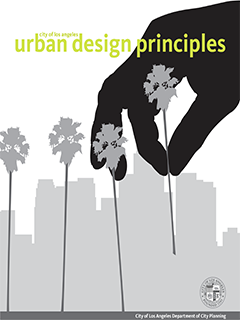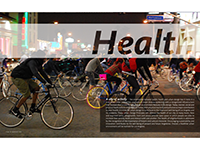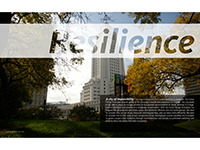Chapter 1: MOVEMENT
A city of mobility - A large city like Los Angeles is in constant motion. You can see it, hear it, feel it and smell it. It surrounds you. It plays a major role in your life. Unfortunately, movement in our city is usually rushed, oblivious and apathetic. As a result, destinations matter, but not the journey. What does that say - that these spaces are not important? The Urban Design Principles state that spaces are vital to the health and sustainability of our neighborhoods. Neighborhoods are where we meet; they keep us connected, they are what we love and dislike about our city and they make us Angelinos. We need the ability to move through and around our spaces. We need Los Angeles to be a city of mobility.
The Urban Design Principles aim to improve how we move in and around Los Angeles; to provide freedom of movement through connections, between and within neighborhoods, and through the city as a whole, through choices in modes of transportation, through safety and security and through the beauty of urban ecology. We want a Los Angeles that embraces the saying, “It’s not where you go, but how you get there.”
Chapter 2: HEALTH
A city of activity - The relationship between public health and urban design has it roots in a time when cities tackled the problems of major disease epidemics with a reorganized infrastructure that incorporated access to light and air as prominent features in its design. Today, mental, social and physical health deficits still plague our cities. With physical inactivity and pollution as major contributors to poor health, it is time for urban design to contribute to the improved well-being of Los Angeles and its residents.
The Urban Design Principles will address the health of our city at many levels. New and improved parks, playgrounds, trails and plazas provide open space in which people are able to increase their activity levels and interact with one another. The health of neighborhoods is addressed by the recognition of the importance of historic and cultural character. Encouraging sustainability and innovation contributes to the well-being of present and future Angelenos. Overall, a healthier urban environment will be realized for Los Angeles.
Chapter 3: Resilience
A city of responsibility - An important quality for a sustainable city is resilience. The Urban Design Principles provide guidance for creating a liveable and adaptable Los Angeles. The city needs to be able to adapt to change; whether it is economic, environmental or social; whether it is large scale or localized; and whether it is temporary or permanent.
With the Urban Design Principles, Los Angeles can be proactive and create spaces that welcome different uses and varied groups. We need to consider how we use all our resources--existing and new--and use them more efficiently. We need to consider the full life cycle of each component of our development puzzle and allow the Principles to guide a project from inception, through implementation and include its continued usefulness and amenity when the project has been completed.



